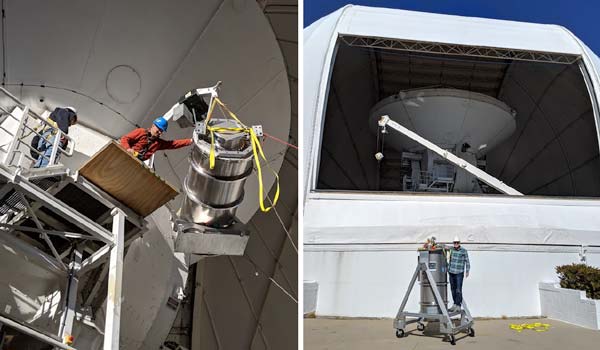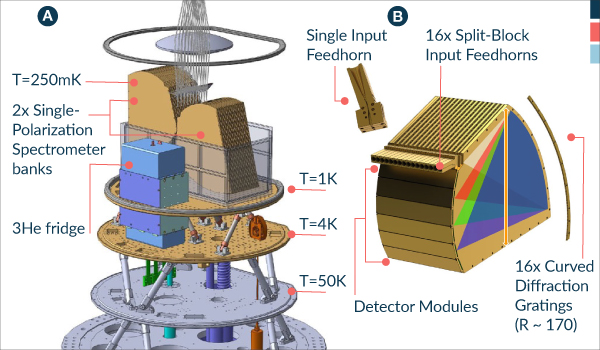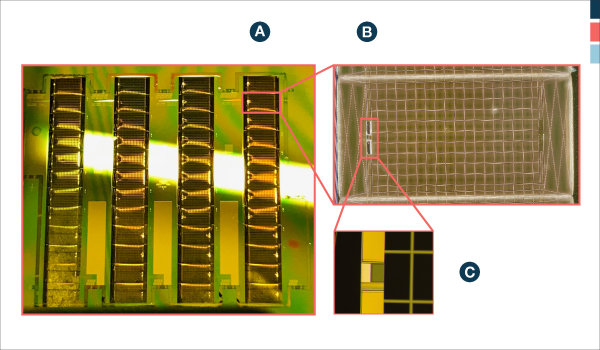Looking Back to the First Stars' Formation
TIME (the Tomographic Ionized Carbon Intensity Mapping Experiment) is the first instrument for spectral imaging array to investigate the early history of the universe.
TIME (the Tomographic Ionized Carbon Intensity Mapping Experiment) is the first instrument of its kind, a spectral imaging array designed to map the emission of carbon monoxide and ionized carbon from distant galaxies. The main science motivation is investigation of the epoch of reionization, the period in the history of the universe when the first stars and galaxies formed from primordial hydrogen and helium. The planned survey will map CII as a tracer of ionized matter in this era, reconstructing the history of reionization by using the line to map ionized bubbles without resolving faint galaxies individually. The work is a collaborative effort between the Caltech Observational Cosmology group, JPL, Rochester Institute of Technology, Univ. Arizona, and Academia Sinica Institute of Astronomy and Astrophysics in Taiwan.
The TIME instrument is a novel mm-wavelength grating spectrometer that uses two banks of 16 parallel-plate waveguide spectrometers, each coupling to a single polarization of radiation. The spectrometers are cooled in stages by a 3He fridge to stabilize at 250mK (0.25°K). The spectrometer banks use curved diffraction gratings to disperse and focus collected light onto output arcs that are then absorbed by a series of closely-packed detector arrays designed for a spectral range of 200-300 GHz and a resolving power of l/Dl~100. The heart of each pixel array is a transition edge sensor (TES) bolometer coupled to a gold absorber on a suspended silicon nitride micro-mesh. These detector arrays were fabricated at MDL and demonstrate that science study can be done with variations of proven technology. Future designs developed in JPL will use spectrometers fabricated entirely from lithographed structures, resulting in highly compact spectroscopic arrays amenable to mass fabrication.
During an engineering run at the 12-m ALMA Prototype Antenna on Kitt Peak in Arizona, TIME has detected first astronomical light. These preliminary results are a first step forward towards completing the full instrument and the scientific observations to come.
The collaboration includes JPL members Prof. Jamie Bock (Caltech/JPL), Matt Bradford, Tzu-Ching Chang, Clifford Frez, Anthony Turner, Alexis Weber, Bruce Bumble, and Matt Kenyon. The work of TIME has been supported by the JPL and Caltech President and Director’s Research and Development Fund.
Left: Installation of TIME cryostat into 12-m ALMA prototype antenna on Kitt Peak National Observatory in Arizona.
Right: Jonathon Hunacek, graduate student in the Caltech cosmology group, alongside TIME cryostat.
+ Larger image
A: TIME cryostat schematic, with two spectrometer banks at the top and cooled in multi stages by a 3He ultra-cold refrigeration system. Photo from Hunacek, et al, Proc. of SPIE Vol. 9914 99140L-1.
B: Single spectrometer bank schematic, with input feedhorns for light collection, a curved diffraction grating for focusing and dispersing light onto detector modules that contain the TIME tiles. Photo from Hunacek, et al, J Low Temp Phys (2016) 184:733–738.
+ Larger image
A: Single detector tile fabricated in silicon composed of 12- spectral pixels (vertical) that utilize transistion edge sensors coupled to gold absorbers on silicon nitride micro-mesh.
B: Single spectral pixel with a TES and thin film gold absorber suspended on a silicon nitride micro-mesh for direct absorption.
C: Al /Ti TES-Bolometer suspended on silicon nitride micro mesh.
+ Larger image


